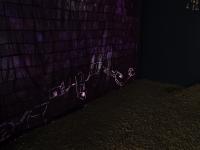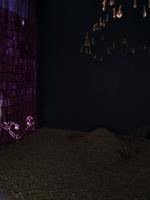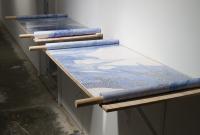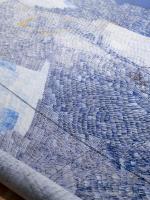Seth Nehil, 2006




Amusia Rite
This work inhabits a small, closed space, suitable for 1 - 5 spectators at a time. The room is painted deep blue and illuminated with blue light. Large sheets of raw muslin, dyed blue and embroidered with white thread, hang on three of the four walls, and the floor is covered with coarse gravel. From the ceiling, at approximately head-level, hang 80 wood-and-felt piano hammers shaped like small feathers or drops. An audio component is contained on three separately cycling cd players, with four speakers mounted in the upper corners of the room, and two along the floor. Amusia Rite contains all that is needed for a landscape - a ground, sky, animal and environmental sound, mental maps. These elements set into play correspondences between acoustic and electromagnetic, natural and electronic, specific and abstract, holding final resolution at bay. The suspended piano hammers are functional objects that have been stilled, they strike their percussive blow at emptiness, waiting for a wind to activate them. The wind has been metaphorically provided by the fabric but moves only in the realm of sound and is therefore ineffectual. The gravel crunches underfoot marking the location of the listener, further indicated by detailed schematic maps embroidered on each of the three muslin drapes. These maps represent the site of the sound-recordings, sound-dreams and sound activities in my childhood neighborhood (as drawn from memory) and posit a tension between the internal space of the sounds and the space of the installation itself. The viewer is dependent on a second hand account of the terrain being shown, twice distorted by memory and depiction. The use of embroidery calls upon an oral tradition and further relates its subjective standpoint. The sounds of billowing fabric, bird and cricket-like bells, crunching pebbles and wind draw an intimate connection with the installation's visual components. These connections operate as an associative circle which is poetic rather than literal, slowly mapping-out the edges of the space as in the descriptive songs of the Kaluli. Fabric on the walls embodies fabric in the recordings. Gravel being crunched on the floor mirrors gravel rising from the speakers, and the "feathers" hanging from the ceiling reference the bird sounds skittering through the air. I also decided to include, as an auxiliary to this environment, two 14' vellum strips which are filled with fields and waves of small blue pen-and-ink hatches. These drawings are displayed on shelves where a viewer can scroll them under a piece of glass. The images slightly hiding under the hatch-marks suggest, among other things, alchemical and scientific equipment from which gas or molecular material is escaping. Fragments of language can be teased out through close study: "Cloud of Steam / #2 Red Catalogue / It collects here / Tool for writing / Facsimile / Membrane", etc. My intention is to point towards the impossibility of containment or measurement within an emergent field.